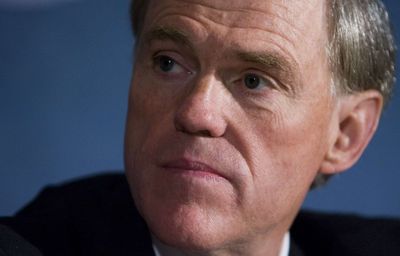Tracing the collapse of WaMu
Longtime CEO relied on aggressive, complex mortgages

Kerry Killinger rose from a job in Spokane as strategist at the brokerage firm Murphey Favre to become Washington Mutual’s chief executive in 1990. He made his first significant money by flipping investment homes in Eastern Washington and deeply believed in the power of the housing industry.
Killinger was all about the business of mortgages and engineered the bank acquisitions that would make WaMu the nation’s largest residential lender. In the end, it was a loan, dubbed “the only loan you’ll ever need,” that brought the bank down – along with the customers who yanked their deposits because of the loan’s reputation.
Killinger was removed as chairman a few weeks ago, just before the bank was handed over to the Federal Deposit Insurance Corp. and sold to JP Morgan Chase in the biggest bank failure in U.S. history.
The Option ARM will be the loan that will be blamed for Washington Mutual’s demise.
The bank believed the loan was a creative mortgage that would help a variety of borrowers in various stages of their lives. The loan gave borrowers choices over their payments each month, providing an opportunity to adjust payments according to cash flow. Because of its flexibility, it was promoted as “the only loan you’ll ever need.”
After the start period, customers could select among four payments each month for the life of the loan. Borrowers were never locked in to a specific payment or amount.
Here were the options:
•Minimum payment – Very low payment, which left the borrower with more cash during lean months. However, at times the amount might not have been enough to cover the interest portion of the loan. If so, that amount was added to the remaining balance.
•Interest-only payment – Amount is the interest portion and any deferred interest the may have accrued. While the original loan amount wasn’t reduced, the borrower didn’t “go backwards” or owe more than borrowed.
•Regular payment – This is a common 30-year fixed-rate loan payment. This option would cover the interest and principal needed to pay off the loan on time.
•Accelerated payment – This schedule would pay off the loan in 15 years. The payment was higher, but substantial interest dollars were saved while gaining equity faster.
But customers got lulled into making minimum payments far too long, compiling substantially more debt than the original loan amount. Others used the loan to get into homes they realistically could not afford. More importantly, the bank accepted Option ARMs from brokers who did a rotten job of explaining how the loan worked.
The Option ARM was a microcosm of the WaMu mortgage acquisition spree.
The prevailing philosophy had been that brokers and bankers should always “get” what WaMu was offering. It was almost as if Killinger’s troops were confounded that mortgage reps – both in-house and brokers – were too slow to grasp the terrific programs the bank was making available.
For example, while Washington Mutual had offered adjustable rate mortgages in the past, its bread and butter had always been 30-year fixed-rate loans – with a 20 percent down payment.
Meanwhile, American Savings and Great Western, two large lenders that WaMu acquired in 1996 and 1997, had huge pipelines for ARMs, including the then-hip COFI ARM whose index was the less volatile Cost of Funds Index, or COFI. Killinger and company felt all of the new mortgage businesses would dovetail nicely under the Washington Mutual umbrella.
By 1998 the stress of bringing WaMu’s mortgage strategy to all newcomers was clearly showing. An unnerving number of mortgage payments were lost or misplaced, county property taxes were mishandled and loan documents arrived late at escrow offices. Efforts were made to improve service, but the anticipated seamless mergers did not happen.
Killinger clearly understood how mortgages worked.
He relied on the housing industry to get ahead in the business world and was eager to have his bank provide as many options as possible for consumers while capturing a formidable market share in an industry where competition was fierce and profit margins were shrinking.
Many consumers and brokers simply didn’t “get” all of WaMu’s options. Others clearly understood but were motivated by attractive commission fees or the possibility of living in a home they could not truly afford.
The bank kept accepting the loans from just about all who wanted to opt in. Now, many consumers simply can’t opt out.